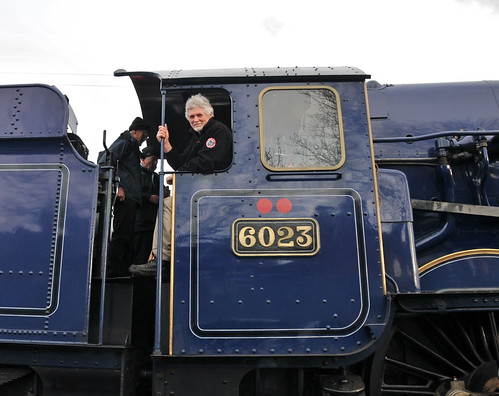
Great Central Railway Loughborough Leicestershire 26th January 2013, originally uploaded by loose_grip_99.
Few people alive will remember this striking colour scheme which was introduced when the railways were nationalised in 1948 but had disappeared by 1954. It distils the mood of post-war optimism - the belief in a better future after the austerity years. The engineers of the time were both forward-looking and backwards-looking. The colour scheme was a revival of the Caledonian Railways livery previously last seen in 1923, and it actually popped up again in 1960 when the Glasgow suburban railways were electrified. The trouble with the blue, and the red and cream colour scheme for the carriages, was that it needed attention which was not forthcoming in the post-war years of labour shortage. So the blue was replaced by a dark green and the carriages went into maroon, a dignified though muted scheme which was enhanced by a heraldic badge. It all seems very distant now, when colour schemes are devised by public relations companies and applied as stick-on vinyls.
But the post-war railways were not a stick-in-the-mud outfit. There were experiments with diesel traction both for local and main line use. British Railways was a pioneer in the development of the now standard 25kV 50Hz system of electrification, with the conversion of three old trains fitted with amongst the very first solid state high power rectifiers, made of germanium, a rare and expensive element. A coherent modernisation scheme was put together, with the aim of electrifying all the main lines and the busier suburban routes and using diesel-electric traction as a stop-gap. Rail-buses were to be used on routes with light traffic. To give an indication of the rate of change, it was expected that steam traction would finally disappear in the mid-1980s, and so construction continued until 1960.
As things turned out, it was all very different. The railways became a political football. The evolutionary approach was abandoned. Under government pressure, the railways were instructed to order, in large numbers, diesel types intended for pilot-scale testing. Whole fleets suffered from the inevitable teething troubles. Modern, almost new steam locomotives went for scrap. Main line electrification proceeded slowly. The railways were stuck with diesels. The line from London to Edinburgh was not completed until 1992, and electrification of the Great Western main line is only now beginning. There are no current plans to electrify other important routes such as the Great Western line from London to Birmingham and Bristol to Birmingham.
Then came Beeching and a huge trimming back of the system, the un-wisdom of which is only now being recognised.
Of course the subsequent story is not all bad. There have been some successes: the long-lived HST, not my favourite train but it has done sterling service. The BREL development of the International Train, which unfortunately did not become a standard. And the much maligned Leyland railbus - which has also given 25 years of useful work on secondary routes which, when the bottom line is all that matters, would have probably lost their services altogether
Kommentarer